Tamilnadu State Board New Syllabus Samacheer Kalvi 12th Economics Guide Pdf Chapter 7 International Economics Text Book Back Questions and Answers, Notes.
Tamilnadu Samacheer Kalvi 12th Economics Solutions Chapter 7 International Economics
12th Economics Guide International Economics Text Book Back Questions and Answers
PART- A
Multiple Choice questions
Question 1.
Trade between two countries is known as ………………… trade.
a) External
b) Internal
c) Inter-regional
d) Home
Answer:
a) External
Question 2.
Which of the following factors influence trade?
a) The stage of development of a product.
b) The relative price of factors of productions.
c) Government
d) All of the above
Answer:
d) All of the above
![]()
Question 3.
International trade differs from domestic trade because of
a) Trade restrictions
b) Immobility of factors
c) Different government polices
d) All the Above
Answer:
d) All the Above
Question 4.
In general, a primary reason why nations conduct international trade is because
a) Some nations prefer to produce one thing while others produce another
b) Resources are not equally distributed among all trading nations
c) Trade enhances opportunities to accumulate profits
d) Interest rates are not identical in all trading nations
Answer:
b) Resources are not equally distributed among all trading nations
![]()
Question 5.
Which of the following is a modern theory of international trade?
a) Absolute cost
b) Comparative cost
c) Factor endowment theory
d) none of these
Answer:
c) Factor endowment theory
Question 6.
Exchange rates are determined in
a) Money Market
b) foreign exchange market
c) Stock Markét
d) Capital Market
Answer:
b) foreign exchange market
![]()
Question 7.
Exchange rate for currencies is determined by supply and demand under the system of
a) Fixed exchange rate
b) Flexible exchange rate .
c) Constant
d) Government regulated
Answer:
b) Flexible exchange rate .
Question 8.
‘Net export equals ………………..
a) Export x Import
b) Export + Import
c) Export – Import
d) Exports of services only
Answer:
c) Export – Import
![]()
Question 9.
Who among the following enunciated the concept of single factoral terms of trade? .
a) Jacob Viner
b) G.S.Donens
c) Taussig
d) J.S.Mill
Answer:
a) Jacob Viner
Question 10.
Terms of Trade of a country show …………..
a) Ratio of goods exported and imported
b) Ratio of import duties
c) Ratio of prices of exports and imports
d) Both (a) and (c)
Answer:
c) Ratio of prices of exports and imports
![]()
Question 11.
Favirnrable trade means value of exports are ………………… than that of imports.
a) More
b) Less
c) More or Less
d) Not more than
Answer:
a) More
Question 12.
If there is an imbalance in the trade balance (more imports than exports), it can be reduced by ……………….
a) Decreasing customs duties
b) Increasing export duties
c) Stimulating exports
d) Stimulating imports
Answer:
c) Stimulating exports
![]()
Question 13.
BOP includes . :
a) Visible items only
b) invisible items only
c) both visible and invisible items
d) merchandise trade only
Answer:
c) both visible and invisible items
Question 14.
Components of balance of payments of a country includes
a) Current account
b) Official account
c) Capital account
d) All of above
Answer:
d) All of above
![]()
Question 15.
In the case of BOT,
a) Transactions of goods are recorded.
b) Transactions of both goods and services’ are recorded
c) Both capital and financiál accounts are included
d) All of these
Answer:
a) Transactions of goods are recorded.
Question 16.
Tourism and travel are classified in which of balance of payments accounts?
a) merchandise trade account
b) services account
c) unilateral transfers account
d) capital account
Answer:
b) services account
![]()
Question 17.
Cyclical disequlibrium in BOP occurs because of
a) Different paths of business cycle.
b) The income elasticity of demand or price elasticity of demand is different.
c) long – run changes in an economy
d) Both (a) and (b).
Answer:
d) Both (a) and (b).
Question 18.
Which of the following is not an example of foreign direct investment?
a) The construction of a new auto assembly plant overseas
b) The acquisition of an existing steel mill overseas
c) The purchase of bonds or stock issued by a textile company overseas
d)The creation of a wholly owned business firm overseas
Answer:
c) The purchase of bonds or stock issued by a textile company overseas
![]()
Question 19.
Foreign direct investments not permitted in India
a) Banking
b) Automatic energy
c) Pharmaceutical
d) Insurance
Answer:
b) Automatic energy
Question 20.
Benefits of FDI include, theoretically
a) Boost in Economic Growth
b) Increase in the import and export of goods and services
c) Increased employment and skill levels
d) All of these
Answer:
d) All of these
![]()
PART – B
Answer the following questions.
Each question carries 2 marks.
Question 21.
What is International Economics?
Answer:
- International Economics is that branch of economics which is concerned with the exchange of goods and services between two or more countries. Hence the subject matter is mainly related to foreign trade.
- International Economics is a specialized field of economics which deals with the economic interdependence among countries and studies the effects of such interdependence and the factors that affect it.
Question 22.
Define international trade.
Answer:
It refers to the trade or exchange of goods and services between two or more countries.
Question 23.
State any two merits of trade.
Answer:
- Trade is one of the powerful forces of economic integration.
- The term ‘trade’ means the exchange of goods, wares or merchandise among people.
![]()
Question 24.
What is the main difference between Adam Smith and Ricardo with regard to the emergence of foreign trade?
Answer:
According to Adam Smith, the basis of international trade was absolute cost advantage whereas Ricardo demonstrates the comparative cost Advantage.
Question 25.
Define terms of Trade.
Answer:
Terms of Trade:
- The gains from international trade depend upon the terms of trade which refers to the ratio of export prices to import prices.
- It is the rate at which the goods of one country are exchanged for goods of another country’.
- It is expressed as the relation between export prices and import prices.
- Terms of trade improve when average price of exports is higher than the average price of imports.
Question 26.
What do you mean by balance of payments?
Answer:
BOP is a systematic record of a country’s economic and financial transactions with the rest of the world over a period of time.
![]()
Question 27.
What is meant by Exchange Rate?
Answer:
Meaning of Foreign Exchange (FOREX):
1. FOREX refers to foreign currencies. The mechanism through which payments are effected between two countries having different currency systems is called the FOREX system. It covers methods of payment, rules and regulations of payment and the institutions facilitating such payments.
2. “FOREX is the system or process of converting one national currency into another, and of transferring money from one country to another”.
PART -C
Answer the following questions.
Each question carries 3 marks.
Question 28.
Describe the subject matter of International Economics.
Answer:
- Pure Theory of Trade:
This component includes the causes for foreign trade, and the determination of the terms of trade and exchange rates. - Policy Issues:
Under this part policy issues regarding international trade are covered. - International Cartels and Trade Blocs:
This part deals with the economic integration in the form of international cartels, trade blocs and also the operation of MNCs. - International Financial and Trade Regulatory Institutions:
The financial institutions which influence international economic transactions and relations shall also be the part of international economics.
![]()
Question 29.
Compare the Classical Theory of international trade with the Modern Theory of International trade.
Answer:
|
Classical Theory of International Trade |
Modern Theory of Internationa] Trade |
| 1. This theory explains the phenomenon of international trade on the basis of labour theory of value. | This theory explains the phenomenon of international trade on the basis of general theory of value. |
| 2. It Presents a one factor model. | It presents a multi factor model. |
| 3. It attributes the difference in the comparative costs to differences in the productive efficiency of workers in the two countries. | It attributes the differences in comparative costs to the differences in factor endowment in the two countries. |
Question 30.
Explain the Net Barter Terms of Trade and Gross Barter Terms of Trade.
Answer:
Net Barter Terms of Trade and Gross Barter Terms of Trade was developed by Taussig in 1927.
Net Barter Terms of Trade: .
It is the ratio between the prices of exports and of imports is called the ” net bar-ter terms of trade”.
It is expressed as
Tn = (Px/Pm) x 100
Tn- Net Barter Terms of Trade
Px – Index number of export Prices
Pm – Index number of import prices .
Gross barter terms of trade:
It is an index of relationship between total physical quantity of imports and the total physical quantity of exports.
Tg = (Qm/ Qx) x 100
Qm – Index of import quantities
Qx – Index of export quantities
![]()
Question 31.
Distinguish between Balance of Trade and Balance of Payments.
Answer:
Balance of Trade and Balance of payments are two different concepts in the sub-ject of International trade.
|
Balance of Trade |
Balance of Payments |
| 1.Balance of Trade refers to the total value of a country’s exports of commodities and total value of imports of commodities. | 1. Balance of payments is a systematic record of a country’s economic and financial transactions with the rest of the world over a period of time. |
| 2. There are two types of BOT, they are favourable balance of Trade and unfavourable balance of Trade. | 2. There are two types of BOP’s they are favourable BOP and unfavorable BOP. |
Question 32.
What are import quotas?
Answer:
Import Control: Imports may be controlled by
- Imposing or enhancing import duties
- Restricting imports through import quotas
- Licensing and even prohibiting altogether the import of certain non-essential items. But this would encourage smuggling.
Question 33.
Write a brief note on the flexible exchange rate.
Answer:
Under the flexible exchange rate also known as the floating exchange rate system exchange rates are freely determined in an open market by market forces of demand and supply.
![]()
Question 34.
State the objectives of Foreign Direct Investment.
Answer:
FDI has the following objectives.
- Sales Expansion
- Acquisition of resources
- Diversification
- Minimization of competitive risk
PART – D
Answer the following questions.
Each question carries 5 marks.
Question 35.
Discuss the differences between Internal Trade and International Trade.
Answer:
|
Internal Trade |
International Trade |
| 1. Trade takes place between different individuals and firms within the same nation. | Trade takes place between different individuals and firms in different countries. |
| 2. Labour and capital move freely from one region to another. | 2. Labour and capital do not move easily from one nation to another. |
| 3.There will be free flow of goods and services since there are no restrictions. | 3. Goods and services do not easily move from one country to another since there are a number of restrictions like tariff and quota. |
| 4.There is only one common currency. | 4. There are different currencies. |
| 5. The physical and geographical conditions of a country are more or less similar. | 5. There are differences in physical and geographical conditions of the two countries. |
| 6.Trade and financial regulations are more or less the same. | 6. Trade and financial regulations such as interest rate, trade laws differ between countries. |
Question 36.
Explain briefly the Comparative Cost Theory.
Answer:
- David Ricardo formulated a systematic theory called’ Comparative cost Theory.
Later it was refined by J.S.Mill, Marshall, Taussig and others. - Ricardo demonstrates that the basis of trade is the comparative cost difference.
- In other words, trade can take place even if the absolute cost difference is absent but there is comparative cost difference.
Assumptions:
- There are only two nations and two commodities.
- Labour is the only element of cost of production.
- All labourers are of equal efficiency.
- Labour is perfectly mobile within the country but perfectly immobile between countries.
- Production is subject to the law of constant returns.
- Foreign trade is free from all barriers.
- No change in technology.
- No transport cost.
- Perfect Competition.
- Full employment.
- No government intervention.
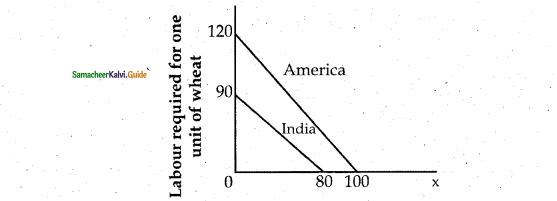
|
Country |
Cloth | Wheat |
Domestic Exchange Ratios |
| America | 100 | 120 | 1 Wheat = 1.2 cloth |
| India | 90* | 80 | 1 Wheat = 0.88 cloth |
Illustration:
- Ricardo’s theory of comparative cost can be explained with a hypothetical example of production costs of cloth and wheat in America and India.
- However, India should concentrate on the production of wheat in which she enjoys a comparative cost advantage. \((80 / 120 \leq 90 / 100)\)
- For America the comparative Cost disadvantage is lesser in cloth production. Hence America will specialize in the production of cloth and export it to India is exchange for wheat.
- With trade, India can get I unit of cloth and I unit of wheat by using its 160 labour units. Otherwise, India will have to use 170 units of labour, America also gains from this trade.
With trade, America can get 1 unit of cloth and one unit of wheat by using its 200 units of labour. Otherwise, America will have to use 220 units of labour for getting 1 unit of cloth and 1 unit of wheat.
Criticism:
- Labour cost is a small portion of the total cost. Hence, theory based on labor cost is unrealistic.
- Labourers in different countries are not equal in efficiency.
![]()
Question 37.
Discuss the Modern Theory of International Trade.
Answer:
Introduction:
The Modern theory of international trade was developed by Swedish economist Eli Heckscher and Bertil Ohlin in 1919.
The Theory:
This model was based on the Ricardian theory of international trade. This theory says that the basis for international trade is the difference in factor endowments. It is otherwise called as ‘Factor Endowment’
This Theory attributes international differences in comparative costs to
- The difference in the endowments of factors of production between countries, and
- Differences in the factor proportions required in production.
Assumptions:
- There are two countries, two commodities and two factors.
- Countries differ in factor endowments.
- Commodities are categorized in terms of factor density.
- Countries use same production technology.
- Countries have identical demand conditions.
- There is perfect competition.
Explanation:
According to Heckscher – Ohlin, a capital-abundant country will export capital-intensive goods, while the labour-abundant country will export the labor-intensive goods’.
Illustration:
|
Particulars |
India |
America |
| Supply of Labour | 50 | 24 |
| Supply of Capital | 40 | 30 |
| Capital – Labour Ratio | 40/50 = 0.8 | 30/24 = 1.25 |
In the above example, even though India has more capital in absolute terms, America is more richly endowed with capital because the ratio of capital in India is 0.8 which is less than that in America where it is 1.25. The following diagram illustrate the pattern of World Trade.

Limitations:
- Factor endowment of a country may change over time.
- The efficiency of the same factor may differ in the two countries.
Question 38.
Explain the types of Terms of Trade given by Viner.
Answer:
Terms of Trade related to the Interchange between Productive Resources:
1. The Single Factorial Terms of Trade:
Viner has devised another concept called “the single factor terms of trade” as an improvement upon the commodity terms of trade. It represents the ratio of the export price index to the import-price index adjusted for changes in the productivity of a country’s factors in the production of exports. Symbolically, it can be stated as
Tf = (Px / Pm ) Fx
Where Tf stands for single factorial terms of trade index. Fx stands for productivity in exports (which is measured as the index of cost in terms of quantity of factors of production used per unit of export).
2. Double Factorial Terms of Trade:
Viner constructed another index called “Double factorial terms of Trade”. It is expressed as
Tff = (Px / Pm )(Fx / Fm)
which takes into account the productivity in the country’s exports, as well as the productivity of foreign factors.
Here, Fm represents the import index (which is measured as the index of cost in terms of quantity of factors of production employed per unit of imports).
![]()
Question 39.
Bring out the components of the balance of payments account.
Answer:
The components of the BOP account of a country are:
- The current account
- The capital account
- The official Reserve assets Account
The Current Account:
It includes all international trade transactions of goods and services, international service transactions, and international unilateral transfers.
The Capital Account:
Financial transactions consisting of direct investment and purchase of interest-bearing financial instruments, non-interest bearing demand deposits and gold fall under the capital account.
The official Reserve Assets Account:
Official reserve transactions consist of movements of international reserves by governments and official agencies to accommodate imbalances arising from the current and capital accounts.
The official reserve assets of a country include its gold stock, holdings of its convertible foreign currencies and Special Drawing Rights and its net position in the International Monetary Fund.
Question 40.
Discuss the various types of disequilibrium in the balance of payments.
Answer:
Types BOP Disequilibrium:
There are three main types of BOP Disequilibrium, which are discussed below.
- Cyclical Disequilibrium,
- Secular Disequilibrium,
- Structural Disequilibrium.
1. Cyclical Disequilibrium:
Cyclical disequilibrium occurs because of two reasons. First, two countries may be passing through different phases of business cycle. Secondly, the elasticities of demand may differ between countries.
2. Secular Disequilibrium:
The secular or long-run disequilibrium in BOP occurs because of long-run and deep-seated changes in an economy as it advances from one stage of growth to another. In the initial stages of development, domestic investment exceeds domestic savings and imports exceed exports, as it happens in India since 1951.
3. Structural Disequilibrium:
Structural changes in the economy may also cause balance of payments disequilibrium. Such structural changes include the development of alternative sources of supply, the development of better substitutes, exhaustion of productive resources or changes in transport routes and costs.
Question 41.
How the Rate of Exchange is determined? Illustrate.
Answer:
The equilibrium rate of exchange is determined in the foreign exchange market in accordance with the general theory of value ie, by the interaction of the forces of demand and supply. Thus, the rate of exchange is determined at the point where demand for forex is equal to the supply of forex.
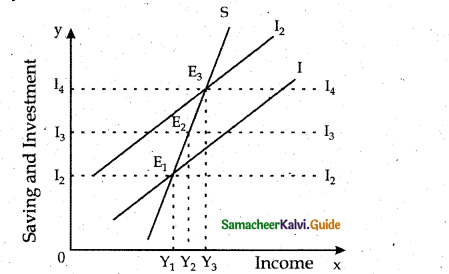
In the above diagram, Y-axis represents the exchange rate, that is the value of the rupee in terms of dollars. The X-axis represents demand and supply for forex. E is the point of equilibrium where DD intersects SS. The exchange rate is P2.
Question 42.
Explain the relationship between Foreign Direct Investment and economic development.
Answer:
- FDI is an important factor in the global economy.
- Foreign trade and FDI are closely related. In developing countries like India
- FDI in the natural resource sector, including plantations, increases trade volume.
- Foreign production by FDI is useful to substitute foreign trade.
- FDI is also influenced by the income generated from the trade and regional integration schemes.
- FDI is helpful to accelerate the economic growth by facilitating essential imports needed for carrying out development programmes like capital goods, technical know-how, raw materials, and other inputs, and even scarce consumer goods.
- FDI may be required to fill the trade gap.
- FDI is encouraged by the factors such as foreign exchange shortage, desire to create employment, and acceleration of the pace of economic development.
- Many developing countries strongly prefer foreign investment to imports.
- However, the real impact of FDI on different sections of an economy.
12th Economics Guide International Economics Additional Important Questions and Answers
One mark
Question 1.
Foreign trade means ………………………..
(a) Trade between nations of the world
(b) Trade among different states
(c) Trade among two states
(d) Trade with one nation
Answer:
(a) Trade between nations of the world
Question 2.
Inter-regional trade is otherwise called as …………………………
a) Domestic trade
b) International trade
c) Internal trade
d) Trade
Answer :
b) International trade
![]()
Question 3.
‘Principles of Political Economy and Taxation’was published by ……………………
a)J.S.Mill
b) Marshall
c) Taussig
d) E)avid Ricardo
Answer:
d) David Ricardo
Question 4.
The exports of India are broadly classified into ……………………….. categories.
(a) Two
(b) Three
(c) Four
(d) Five
Answer:
(c) Four
Question 5.
Net Barter Terms of Trade was developed by …………………..
a) Torrance
b) Taussig
c) Marshall
d) J. S.tMill
Answer:
b) Taussig
Question 6.
Favourable Balance of payment is expressed as …………..
a) R/P = 1
b) R/P < 1
c) R/P > 1
d)R/P# l
Answer:
c) R/P > 1
![]()
Question 7.
Flexible Exchange Rate is also called as ……………
a) Nominal Exchange Rate
b) Pegged Exchange Rate
c) Floating Exchange Rate
d) Fixed Exchange Rate
Answer:
c) Floating Exchange Rate
Question 8.
The New Export-Import policy was implemented in ………………………..
(a) 1990 – 1995
(b) 1991 – 1996
(c) 1992 – 1997
(d) 1993 – 1998
Answer:
(c) 1992 – 1997
![]()
Question 9.
Inflation and exchange rates are ……………….. related
a) Positive
b) directly
c) inversely
d) negatively.
Answer:
c) inversely
Question 10.
FPI is part of capital account of ………………
a) BOT
b) BOP
c) FDI
d) FIT
Answer:
b) BOP
![]()
Question 11.
……………………….. items means the imports and exports of services and other foreign transfer transactions.
(a) Invisible
(b) Visible
(c) Exports
(d) Imports
Answer:
(a) Invisible
Question 12.
Single Factorial Terms of Trade was devised by …………………
a) Marshall
b) David Ricardo
c) Jacob viner
d) Taussig
Answer:
c) Jacob Viner
II. Match the following
Question 1.
a) Internal trade – 1) Interregional trade
b) International trade – 2) David Ricardo
c) Absolute Cost Advantage – 3) Intraregional trade
d) Comparative cost Advantage – 4) Adam smith
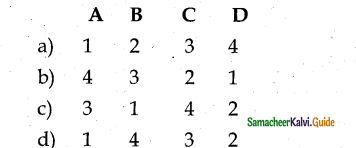
Answer:
c) 3 1 4 2
Question 2.
a) Net Barter Terms of Trade – 1) Tf = (Px / Pm) Fx
b) Gross Barter Terms of Trade – 2) Tf = (Px / Pm) Qx
c) Income Terms of Trade – 3) Tg = (Qm / Qx) x 100
d) Single factoral terms of Trade – 4) Tn = (Px / Pm) x 100


Answer:
d) 4 3 2 1
Question 3.
a) Fixed Exchange Rate – 1) NEER
b) Flexible Exchange Rate – 2) REER
c) Nominal Effective Exchange Rate – 3) Pegged exchange rate
d) Real Effective Exchange Rate – 4) Floating exchange rate
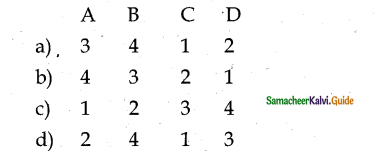
Answer:
a) 3 4 12
III. Choose the correct pair
Question 1.
a) Inflation, Exchange Rate – Directly related
b) Interest rate, Exchange Rate – Inversely related
c) Public Debt – reduces inflation
d) Inflation – The exchange rate will be lower
Answer:
d) Inflation – The exchange rate will be lower
Question 2.
a) Foreign Exchange – FOREX
b) Foreign Direct Investment – FII
c) Foreign Portfolio Investment – FDI
d) Foreign Institutional Investment – FPI
Answer:
a) Foreign Exchange – FOREX
![]()
Question 3.
a) Economic Reforms – 1992
b) Unfavourable BOP – R / P > 1
c) Favourable BOP – R/P<1
d) Devaluation of Indian currency – 29th September 1949
Answer:
d) Devaluation of Indian currency – 29th September 1949
IV. Choose the Incorrect pair
Question 1.
a) Demonstration Effect – Propensity to import
b) Cyclical Disequilibrium – Elasticities of demand remain constant
c) Secular Disequilibrium – Domestic investment exceeds domestic savings
d) Structural Disequilibrium – exhaustion of productive resources.
Answer:
b) Cyclical Disequilibrium – Elastic cities of demand remain constant
Question 2.
a) Absolute cost Advantage – Adam smith
b) Comparative cost Advantage – Ricardo
c) International product life cycle – J.S.Mill
d) Factor Endowment theory – Heckscher and Ohlin
Answer:
c) International product life cycle – J.S.Mill
![]()
3. a) Net Barter Terms of Trade – Taussig
b) Income Terms of Trade – Taussig
c)The single factorial terms of trade – Viner
b) International product life cycle – Ray Vernon
Answer:
b) Income Terms of Trade – Taussig
V. Choose the correct statement
Question 1.
a) International Economics is concerned with the exchange of goods and services between the people.
b) Absolute cost Advantage theory is based on the assumption of two countries and single commodity.
c) David Ricardo published the book ‘Principles of Political Economy and Taxation’.
d) Heckscher – ohlin theory of international trade is called as classical theory of international trade.
Answer:
c) David Ricardo published the book ‘Principles of Political Economy and Taxation’.
Question 2.
a) The gains from international trade depend upon the terms of trade.
b) Gerald M. Meier classified Terms of trade into four categories.
c) Gross barter terms of trade is named as commodity terms of trade by Viner.
d) The single Factoral Terms of Trade was devised by Taussig.
Answer:
a) The gains from international trade depend upon the terms of trade.
![]()
Question 3.
a) When receipts exceed payments, the BOP is said to be unfavourable.
b) When receipts are less than payments, the BOP is said to be favourable.
c) The BOP is said to be balanced when the receipts and payments are just equal.
d) Cyclical disequilibrium is caused by structural changes.
Answer:
c) The BOP is said to be balanced when the receipts and payments are just equal.
VI. Choose the incorrect statement:
Question 1.
a) Demonstration effects raise the propensity to import causing adverse balance of payments.
b) A rise in interest rate reduces foreign investment.
c) Devaluation refers to a reduction in the external value of a currency in the terms of other currencies.
d) The mechanism through which payments are effected between two countries having different currency systems is called FOREX system.
Answer:
b) A rise in interest rate reduces foreign investment.
Question 2.
a) FOREX refers to foreign currencies.
b) Exchange rate may be defined as the price paid in the home currency for a unit of foreign currency.
c) The equilibrium exchange rate is that rate, which over a certain period of time, keeps the balance of payments in equilibrium. .
d) Flexible Exchange Rate is also known as pegged exchange rate.
Answer:
d) Flexible Exchange Rate is also known as pegged exchange rate.
![]()
Question 3.
a) Terms of Trade refers to the ratio of export prices to import prices.
b) International Economics is concerned with the exchange of goods and services between two or more countries.
c) Terms of trade is the rate at which the goods of one country are exchanged for goods of another country.
d) Indian rupee was devalued four times since 1947.
Answer:
d) Indian rupee was devalued four times since 1947
VII. Pick the odd one out:
Question 1.
a) Nomina] Exchange rate
b) Flexible Exchange rate .
c) Real Exchange rate
d) Nominal Effective Exchange rate
Answer:
b) Flexible Exchange rate
Question 2.
a) The major sectors that benefited from FDI in India are:
a) atomic energy
b) Insurance
c) telecommunication
d) Pharmaceuticals.
Answer :
a) atomic energy
VIII. Analyse the Reason:
Question 1.
Assertion (A): Foreign investment mostly takes the form of direct investment,
Reason (R): FDI may help to increase the investment level and thereby the income and employment in the host country.
Answer:
b) Assertion (A) and Reason (R) both are true, but (R) is not the correct explanation of (A).
Question 2.
Assertion (A) : Terms of trade refers to the ratio of export prices to import prices.
Reason (R) : The gains from international trade depend upon the terms of trade.
Answer:
a) Assertion (A) and Reason (R) both are true and (R) is the correct explanation of (A)
Question 3.
Assertion (A) : Trade between countries can take place even if the abso¬ lute cost difference is absent but there is the comparative cost difference.
Reason (R) : A country can gain from trade when it produces at relatively lower costs.
Answer:
b) Assertion (A) and Reason (R) both are true, but (R) is not the correct explanation of (A).
Options:
a) Assertion (A) and Reason (R) both are true and (R) is the correct explanation of (A).
b) Assertion (A) and Reason (R) both are true, but (R) is not the correct explanation of (A).
c) Assertion (A) is true, Reason (R) is false.
d) Both (A) and (R) are false.
IX. 2 Mark Questions
Question 1.
Define “Domestic Trade”?
Answer:
- It refers to the exchange of goods and services within the political and geographical boundaries of a nation.
- It is a trade within a country.
- This is also known as ‘domestic trade’ or ‘home trade’ or ‘intra-regional trade’.
Question 2.
Name the types of trade.
Answer:
- Internal Trade
- International Trade.
![]()
Question 3.
What is meant by Internal trade?
Answer:
Internal Trade refers to the exchange of goods and services within the political and geographical boundaries of a nation.
Question 4.
State Adam smith’s theory of Absolute cost Advantage.
Answer:
Adam smith stated that all nations can be benefited when there is free trade and specialisation in terms of their absolute cost advantage.
Question 5.
Write Modern Theory of International Trade Limitations?
Answer:
Limitations:
- Factor endowment of a country may change over time.
- The efficiency of the same factor (say labour) may differ in the two countries.
- For example, America may be labour scarce in terms of number of workers. But in terms of efficiency, the total labour may be larger.
Question 6.
Give note on Income Terms of Trade.
Answer:
Income terms of trade is the net barter terms of trade of a country multiplied by its exports volume index.
![]()
Question 7.
What is Balance of Trade?
Answer:
Balance of Trade refers to the total value of a country’s exports of commodities and total value of imports of commodities.
8. Give note on Balance of Payments Disequilibrium.
The BOP is said to be balanced when the receipts (R) and Payments (P) are just equal.
R/P = 1
![]()
Question 8.
Write favourable and unfavourable balance of payments and equations?
Answer:
Favourable BoP: When receipts exceed payments, the BoP is said to be favourable. That is, R / P > 1.
Unfavourable BOP: When receipts are less than payments, the BoP is said to be unfavourable or adverse. That is, R / P < 1.
Question 9.
Define Equilibrium Exchange Rate.
Answer:
The equilibrium exchange rate is that rate, which over a certain period of time, keeps the balance of payments in equilibrium.
X. 3 Mark Questions
Question 1.
What are the factors determining Exchange Rate?
Answer:
- Differentials in Inflation
- Differentials in Interest Rates
- Current Account Deficits
- Public Debt
- Terms of Trade
- Political and Economic stability
- Recession
- Speculation.
![]()
Question 2.
Write Ricardo’s Theory of Comparative Cost Advantage Assumptions/
Answer:
Assumptions:
- There are only two nations and two commodities (2 × 2 models)
- Labour is the only element of the cost of production.
- All labourers are of equal efficiency.
- Labour is perfectly mobile within the country but perfectly immobile between countries.
- Production is subject to the law of constant returns.
- Foreign trade is free from all barriers.
- No change in technology.
- No transport cost.
- Perfect competition.
- Full employment.
- No government intervention.
Question 3.
Name the Industrial sectors of India where FDI is not permitted.
Answer:
- Arms and ammunition
- Atomic energy
- Railways
- Coal and lignite
- Mining of iron, manganese, chrome, gypsum, sulphur, gold, diamond, copper etc.
XI. 5 Mark Questions
Question 1.
Explain Adam Smith’s Theory of Absolute Cost Advantage.
Answer:
Adam Smith explained the theory of absolute cost advantage in 1776.
Adam Smith argued that all nations can be benefited when there is free trade and specialisation in terms of their absolute cost advantage.
Adam smith’s theory:
According to Adam Smith, the basis of international trade was absolute cost advantage. Trade between two countries would be mutually beneficial when one country produces a commodity at an absolute cost advantage over the other country which in turn produces another commodity at an absolute
cost advantage over the first country.
Assumptions:
- There are two countries and two commodities
- Labour is the only factor of production
- Labour units are homogeneous
- The cost or price of a commodity is measured by the amount of labour required to produce it.
- There is no transport cost.
Illustration:
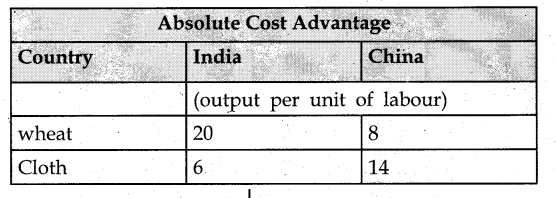
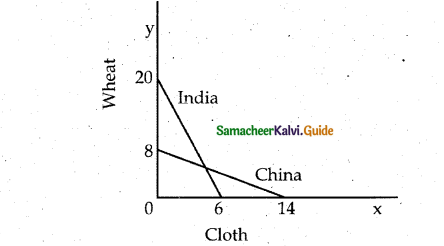
From the illustration, it is clear that India has an absolute advantage in the production of wheat over china and china has an absolute advantage in the production of cloth over India.
Therefore India should specialize in the production of wheat and import cloth from china. China should specialize in the production of cloth and import wheat from India and China.
Question 2.
Briefly explain the Gains from International Trade Categories?
Answer:
Gains from International Trade:
- International trade helps a country to export its surplus goods to other countries and secure a better market for it.
- Similarly, international trade helps a country to import goods which cannot be produced at all or can be produced at a higher cost.
- The gains from international trade may be categorized under four heads.
I. Efficient Production:
- International trade enables each participatory country to specialize in the production of goods in which it has absolute or comparative advantages.
- International specialization offers the following gains.
- Better utilization of resources.
- Concentration in the production of goods in which it has a comparative advantage.
- Saving in time.
- Perfection of skills in production.
- Improvement in the techniques of production.
- Increased production.
- Higher standard of living in the trading countries.
II. Equalization of Prices between Countries:
International trade may help to equalize prices in all the trading countries.
- Prices of goods are equalized between the countries (However, in reality, it has not happened).
- The difference is only with regard to the cost of transportation.
- Prices of factors of production are also equalized (However, in reality, it has not happened).
III. Equitable Distribution of Scarce Materials:
International trade may help the trading countries to have equitable distribution of scarce resources.
IV. General Advantages of International Trade:
- Availability of a variety of goods for consumption.
- Generation of more employment opportunities.
- Industrialization of backward nations.
- Improvement in the relationship among countries (However, in reality, it has not happened).
- Division of labour and specialisation.
- Expansion in transport facilities.
![]()